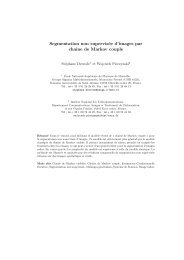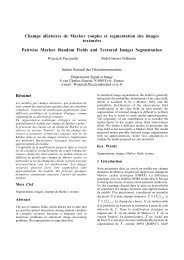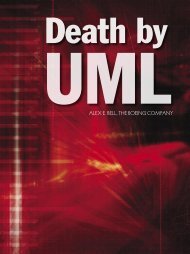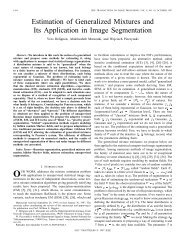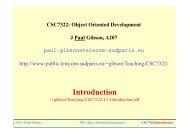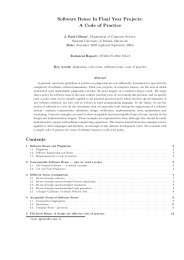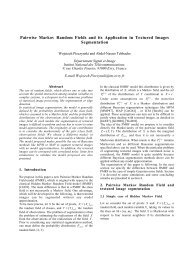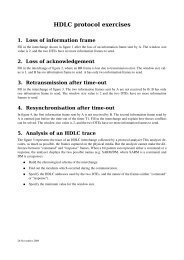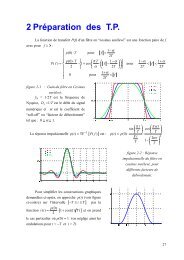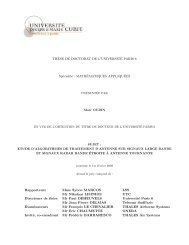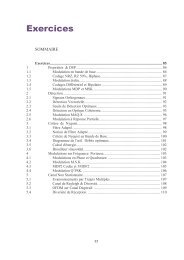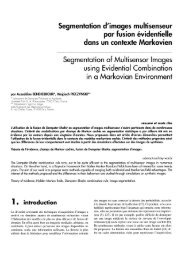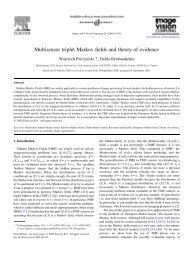Modèles de Markov triplets en restauration des signaux
Modèles de Markov triplets en restauration des signaux
Modèles de Markov triplets en restauration des signaux
You also want an ePaper? Increase the reach of your titles
YUMPU automatically turns print PDFs into web optimized ePapers that Google loves.
BIBLIOGRAPHIE[66] P. Lanchantin, J. Lapuya<strong>de</strong>-Lahorgue, and W. Pieczynski. Unsupervised segm<strong>en</strong>tationof randomly switching data hid<strong>de</strong>n with non-gaussian correlatednoise. Signal Processing, 91(2) :163–175, 2011.[67] P. Lanchantin and W. Pieczynski. Unsupervised non stationary image segm<strong>en</strong>tationusing triplet markov chains. In Advanced Concepts for Intellig<strong>en</strong>tVision Systems (ACIVS 04), Brussels, Belgium, Aug. 31-Sept. 2004.[68] P. Lanchantin and W. Pieczynski. Chaînes et arbres <strong>de</strong> markov évi<strong>de</strong>ntiels avecapplications à la segm<strong>en</strong>tation <strong>de</strong>s processus non stationnaires. Traitem<strong>en</strong>t duSignal, 22(1) :15–26, 2005.[69] P. Lanchantin and W. Pieczynski. Unsupervised restoration of hid<strong>de</strong>n nonstationary markov chain using evi<strong>de</strong>ntial priors. IEEE Trans. on Signal Processing,53(8) :3091–3098, 2005.[70] J. Lapuya<strong>de</strong>-Lahorgue. Sur divers ext<strong>en</strong>sions <strong>de</strong>s chaînes <strong>de</strong> <strong>Markov</strong> cachéesavec applications au traitem<strong>en</strong>t <strong>de</strong>s <strong>signaux</strong> radar. Mathématiques appliquées,Thèse <strong>de</strong> l’Université Paris VI, 2009.[71] J. Lapuya<strong>de</strong>-Lahorgue and W. Pieczynski. Unsupervised segm<strong>en</strong>tation of hid<strong>de</strong>nsemi-markov non stationary chains. In Tw<strong>en</strong>ty six International Workshopon Bayesian Infer<strong>en</strong>ce and Maximum Entropy Methods in Sci<strong>en</strong>ce and Engineering,MaxEnt, Paris, France, July 2006.[72] J. Lapuya<strong>de</strong>-Lahorgue and W. Pieczynski. Partially markov mo<strong>de</strong>ls and unsupervisedsegm<strong>en</strong>tation of semi-markov chains hid<strong>de</strong>n with long <strong>de</strong>p<strong>en</strong><strong>de</strong>nc<strong>en</strong>oise. In International Symposium on Applied Stochastic Mo<strong>de</strong>ls and DataAnalysis, ASMDA, Crete, Grece, May 2007.[73] J. Lapuya<strong>de</strong>-Lahorgue and W. Pieczynski. Unsupervised segm<strong>en</strong>tation ofnew semi-markov chains hid<strong>de</strong>n with long <strong>de</strong>p<strong>en</strong>d noise. Signal Processing,90(11) :2899–2910, 2010.[74] S. L. Lauritz<strong>en</strong>. Graphical mo<strong>de</strong>ls. Clar<strong>en</strong>don Press Oxford, 1996.[75] S. L. Lauritz<strong>en</strong>. Complex Stochastic Systems, chapter Causal Infer<strong>en</strong>ce fromGraphical Mo<strong>de</strong>ls. CRC Press, 2000.[76] B. G. Leroux. Maximum likelihood estimation for hid<strong>de</strong>n markov mo<strong>de</strong>ls.Stochatic Processes and their applications, 40 :127–143, 1992.[77] N. Limnios. Estimation of the stationary distribution of semi-makov processeswith borel state space. Statistics and Probability Letters, 76(14) :1536–1542,2006.[78] N. Limnios and G. Oprisan. Semi-markov processes and reliability. Birkhäuser,2001.[79] Tristan Lorino. Elém<strong>en</strong>ts <strong>de</strong> statistiques - processus stochastiques, Février2005.[80] M. B<strong>en</strong> Mabrouk and W. Pieczynski. Unsupervised segm<strong>en</strong>tation of randomdiscrete data using triplet markov chains. In International Symposium on AppliedStochastic Mo<strong>de</strong>ls and Data Analysis,ASMDA, Crete, Grece, May 2007.[81] B. B. Man<strong>de</strong>lbort and J.W. Van Ness. Fractional brownian motions, fractionalnoises and applicaions. Revue of the Society of Industriel and appliedMathematics, 10(4) :422–437, 1968.133



